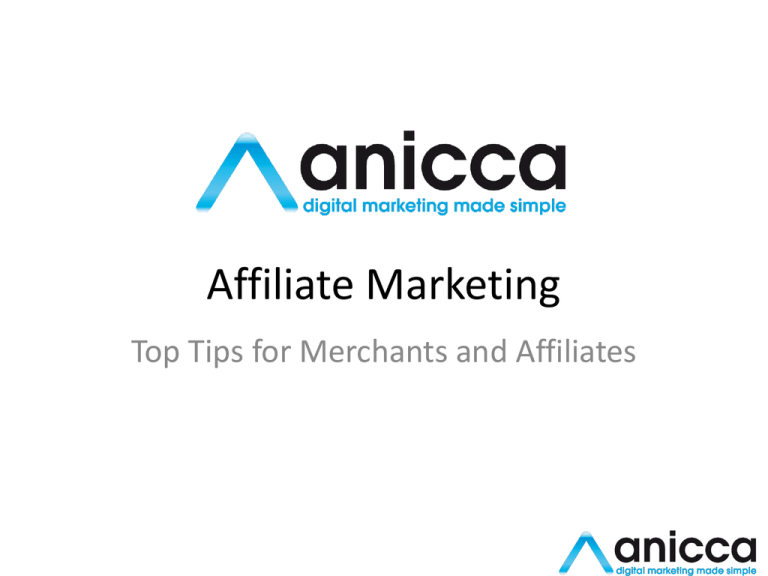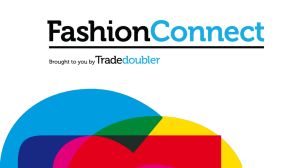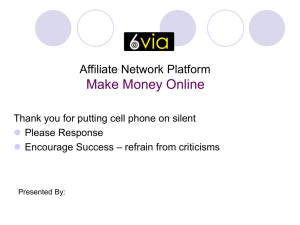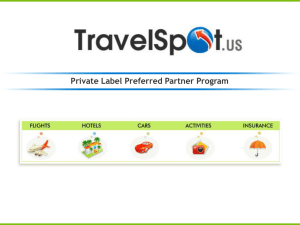Affiliate Marketing
advertisement

Affiliate Marketing Top Tips for Merchants and Affiliates What is affiliate marketing? Definition of affiliate marketing Affiliate marketing is:Where a third party (or Affiliate) generates sales or leads for the seller (or Merchant) and receives a commission for each successful sale or lead Merchants (sellers or service provider) • Merchants include both large multi national companies and smaller businesses • Most Merchants tend to use affiliate marketing to sell products to consumers (so they can pay commission on a sale) but it can be used for lead generation (for the sale of services) and business to business • Affiliate marketing works very well for certain types of Merchants – New businesses (with no SEO traffic) – Companies with low budgets or where the cost per acquisition is expensive using other methods (such as pay per click) – Big brand names that want maximum sales Affiliates (advertisers) • Affiliates can be anybody with a website or blog, that wants to earn some extra cash • These include directory sites, loyalty sites, cash-back sites, sites where you earn points, blogs, other e-commerce sites and shopping site/ecommerce aggregators • Affiliates may already have established traffic, extensive database lists for email marketing, or may use SEO and PPC to get visitors to their site (and then to the Merchants’ sites) Benefits of Affiliate Marketing • • • • Market Development Other people sell for you Pay only when a sale is made Gain new customers at low cost – Often cheaper than PPC – Faster than SEO Sales of products – routes to market DIY Marketing & sales Stockists & resellers Drop shipping Affiliate Productfeeds Affiliate marketing Marketing by Seller 3rd party 3rd party 3rd party 3rd party Money taken by Seller 3rd party 3rd party Seller Seller Product supplied by Seller 3rd party Seller Seller Seller Techniques used Sellers Ecommerce website 3rd party Ecommerce Website with own payments 3rd party Ecommerce website with own payments 3rd party Ecommerce website with links back to sellers site Banners and ads linking to sellers website Sales of services – routes to market DIY Marketing Agents Lead generation Affiliate marketing Marketing by Seller 3rd party 3rd party 3rd party Money taken by Seller 3rd party Seller Seller Product supplied by Seller Seller or 3rd party Seller Seller Techniques used Sellers website 3rd party Website 3rd party Lead generation website Banners and ads linking to sellers website Affiliate marketing of products Affiliate Feed With feeds from various Merchants Affiliate site Marketing carried out by Affiliate Visitors clicks through to Merchants site Merchant Sells product to visitor £ Affiliate marketing of services Affiliate site Marketing carried out by Affiliate £ Visitors clicks through to Merchants site Merchant Visitor completes form Lead generation Visitors details collected and transferred Many affiliates do both? Affiliate and/or lead generation site Marketing carried out by Affiliate Affiliate Feed With feeds from various Merchants Visitors clicks through to Merchants site Product sales Merchant Sells product to visitor £ Lead generation Visitors details collected and transferred Visitors clicks through to Merchants site Merchant Visitor completes form Lead generation Examples of large affiliate sites (super affiliates) Quidco - Cash back Greasy palm - Cashback Mutual points - Earn points MyIce – points to be used online and offline Examples of affiliate product feed sites Example of affiliate product feed sites Example of affiliate product feed sites Example of a banner ad on an affiliate site Shopping directory Click through to M & S – note url has tracking code added AdSense from Google looks like an affiliate ad but you get paid on a click Example of lead generation Business to business advertisers Lead generation site The elements of an affiliate programme How does it work? Tracking Software Goes through Clicks on Redirects to Visitor Affiliate Website Sends commission Merchant Site Key elements of an affiliate programme • Having a programme and commission structure in place to attract affiliates • Getting enough affiliates to join your programme • Ability to track which affiliate generated a successful sale or lead • Easy to manage the programme and pay the affiliates • Ability to reject sales or leads if they are fraudulent or payment is not received Options for managing an affiliate programme • Use an affiliate network – Create your own programme on the network – Use network’s tracking software – Let the network promote and recruit your affiliates – Use networks tools to manage the programme • do this yourself • use networks in-house services (managed service) • recruit an agency Options for managing an affiliate programme • DIY – Set-up your own programme – Invest in third party tracking software – Market and recruit your own affiliates – Manage your programme yourself (or recruit an agency) Example of affiliate software Advantages and disadvantages DIY – using tracking software Advantages Disadvantages No network fees You are in control Best for larger companies with lots of experience and resources Time and skills to set-up scheme Cost of promoting and recruiting affiliates Using an affiliate network Quick set-up Easy to use All affiliates and marketing in place Cost of joining network Over-rider commission to network Monthly fee to network Links benefit to network - not you For small or first time users – we recommend using an affiliate network Using an affiliate network Using an affiliate network • A Merchant registers with an affiliate network and adds their details/programme to the site. • The programme is advertised to the affiliates registered on the network • Affiliates can choose to subscribe to the programmes offered and adds the banner or text ad to their own site. • The affiliate generates traffic or leads for the Merchant • The sale or leads are tracked due to the presence of tracking code on the thank you page of the Merchant’s website and cookies added to the visitors computer • The Merchant pays a price per lead or commission for each lead or sale (via the network) Affiliate Networks Log in as an Affiliate and see the Merchant directory Example of a programme for selling products Creative Example of a programme for lead generation Creative Affiliate feeds Typical costs and commissions Costs and commissions Lower Upper Commission to affiliate (sector and Merchant specific) 5% £1 cost per lead 25% £50 cost per lead Multiple tiers and bonuses for selling certain targets Over-rider commission (paid to network) 25% of commission paid to affiliates (eg 12% to affiliates 3% to network) 30% of commission paid to affiliates (eg 12% to affiliates 4% to network) Set-up fee Free eg Profitistic £1500 - £2000 (larger networks with more affiliates) Monthly fee – DIY (sometimes over-rider is deducted from this) Free eg Profitistic DIY - £75-£150 per month Monthly fee - managed £250/month Up to £850/month Entry criteria None Minimum monthly sales Setting up your programme Choosing an affiliate network – – – – – – – – Set-up costs Monthly costs % Over-rider Number of UK affiliates Sector experiences and other Merchants similar to you Ease of use of interface Minimum contract period Other conditions and costs Preparing your campaign • Apply for an account • Pay deposit/set-up fee • Prepare your programme for affiliates – Provide description of company and website with average sales and order size – Commissions offered (and/or cost per leads) – Bonuses and additional commission tiers for affiliates hitting certain targets – Restrictions eg PPC advertising on brand name – Text and creative (banners and buttons) to be used on affiliate sites • Add tracking code to your site and possibly create a different landing page • Run test and then make live Managing your campaign • Monitor daily and check all sales/leads – reject bogus sales/leads • Reject unsuitable affiliates • Offer monthly promotions and bonuses to increase take-up and sales Likely Results • Expect up to 300 affiliates to sign up for a campaign within the first month • This will increase gradually over 6 months • Most sales will come from a handful of sites (super-affiliates) • You could receive up to a third of your traffic and sales from these sites (seen as referral traffic in Analytics) • It is essential to monitor daily for bogus leads or sales (you have up to 5 days to reject) • Your commission has to be attractive for affiliates to bother to market your product/service, so compare yourself with similar programmes • Offer multiple tiers, bonuses and competitions • Police your affiliates especially if they are “stealing” your PPC traffic Daily deal sites Daily Deals and Voucher Sites Voucher Codes Websites Groupon Groupon Deals • Merchants are mainly local restaurants, beauticians, hotels, entertainment, days out, services • Merchant Develops a deal with Groupon • Usually with 50% discount for a minimum of 50 people • Groupon advertises to e-mail data list within the specified location and on their website as a daily deal or “side deal” • Minimum number of customers have to pay for the deal online • They then receive a voucher code which they redeem with the Merchant. • The Merchant claims 50% of the sale value from Groupon Alternatives to Groupon Alternatives to Groupon • • • • • Lower commission rates Offers run for a longer duration Lower number of database recipients Better admin assistance, e.g. You receive contact details Better terms and conditions for Merchants Mobile Based Deals ˃ Customers can now get deals direct to mobile ˃ Facebook allows users to see what deals are available and their conditions. These include: ˃ Checking-in ˃ Checking-in as a group ˃ Loyalty purchases / check-ins ˃ Charity donations ˃ Foursquare is another emerging mobile site which runs similar offers Thank You








